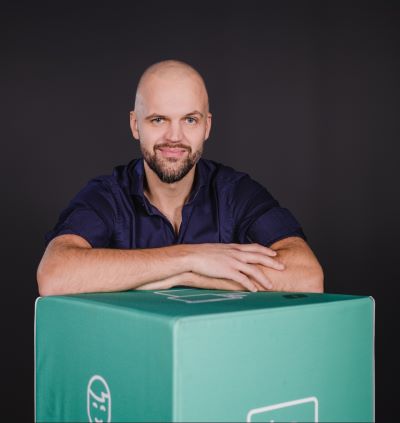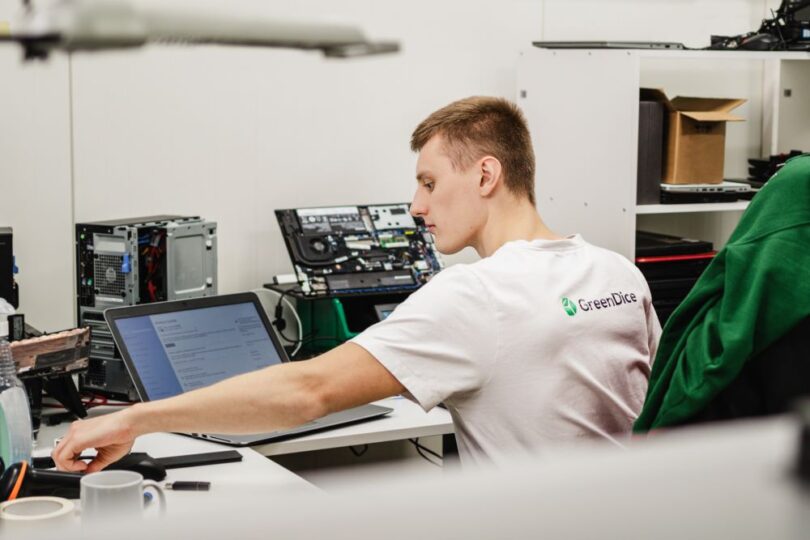GreenDice is an Estonian company on a mission to make digital world entry affordable for everyone. They believe that the key to success in this mission is real and transparent sustainability actions from enterprises.
GreenDice has found a bottleneck where many companies have climate goals towards net zero. Still, they cannot report or measure their everyday IT electronics footprints by not knowing the full life cycle demanded through manufacturers’ methodology. GreenDice believes that it can help enterprises close this loop for environmental terms and add real social impact to their ESG report by making digital world entry start from 5.90€ per month.
How the Concern for the Environment and Lifecycle of Technology Products Led to GreenDice’s Concept
 The main drive behind GreenDice’s concept stems from their founder, Argo Alaniit, who grew up in the countryside in an ex-Soviet Union country where most people were not born with a ‘golden spoon in their mouth’. Estonia had a digital revolution going on and Argo ended up benefitting from access to a computer, where he expanded his knowledge and started small business activities.
The main drive behind GreenDice’s concept stems from their founder, Argo Alaniit, who grew up in the countryside in an ex-Soviet Union country where most people were not born with a ‘golden spoon in their mouth’. Estonia had a digital revolution going on and Argo ended up benefitting from access to a computer, where he expanded his knowledge and started small business activities.
As time went by, he randomly ended up in Morocco as a tourist and started to speak with the local people who almost all were dreaming about emigrating to Europe, because there were limited opportunities inside the country and the salary was very low. Argo explained how his computer gave him a chance to change his life for the better, yet people did not seem to understand.
This led Argo to open a computer class in Morocco some years later. He was on a mission to try and educate people to provide helpdesk solutions, for example for a French bank. Moroccans who joined, appreciated the initiative but asked why they must buy used rubbish/garbage from the EU again… This question was the starting point of GreenDice as it made Argo brainstorm an answer to their question.
Studying environmental engineering at university, Argo knew how complicated it is to achieve carbon neutrality or carbon zero goals. He also had insights about the IT industry and knew that even to measure or report ICT devices’ carbon footprints, you must know the full life cycles of these, which enterprises are lacking. All this led up to an idea where people like Moroccans for example, who would like to benefit from the digital world, could be part of specific companies’ sustainability strategy by transparently helping them to extend the life of once-used devices, while also taking responsibility to recycle them properly by being part of the GreenDice community.
After taking some time to learn what was going on, GreenDice found that only 50% of the world has any kind of access to a personal computer, and that e-waste is the most rapidly growing waste sector in the world. Those two things could be measurably targeted and reduced. While ICT devices could be used to catch millions of people whose mindsets can be shifted towards more sustainable thinking and acting.
Community-subscribers-wise, GreenDice is testing its concept in Estonia for the next upcoming year (2024). Partnership-(enterprises)-wise they are looking into Europe and the UK/USA to bring them a product which could make their sustainability journey more interesting and measurable in terms of impacting society positively.
Read More: Our story – GreenDice
Why Is E-Waste an Issue?
Everything is going to be electric but even now we produce more than 50 million tons of e-waste every single year and it is the most rapidly growing waste sector in the world. 50 million tons… (To understand the size of it, we can imagine that one person weighs 100kg and we “throw” away more than 500 million people every year.)
Unfortunately, only 17% of electronic devices are collected and 83% get lost or dumped. According to the World Health Organization (WHO), it is a major concern where a lot of women and child labourers are facing health risks.
For example, lead is one of the common substances released into the environment if e-waste is recycled, stored, or dumped using inferior activities, such as open burning. E-waste recycling activities may have several adverse impacts on human health, and children and pregnant women are particularly vulnerable – The International Labour Organization (ILO) and WHO estimate that millions of women and child labourers working in the informal recycling sector around the world may be at risk of e-waste exposure.
Now, there are several reasons why some people who claim to be environmentally conscious or “green” may not be aware of e-waste.
Firstly, some people may not have been exposed to information about e-waste, or they may not have had the opportunity to learn more about environmental issues. Another reason could be that people may be aware of the broader environmental issues, but they may not have focused specifically on e-waste. For example, they may be well aware of topics such as pollution, climate change, or conservation, without delving into the specifics of electronic waste. Extending on from that, while many people consider themselves environmentally conscious, they may prioritise certain aspects like reducing plastic waste in their home, conserving energy, or supporting renewable energy sources, while disregarding e-waste.
However, this is understandable, as in today’s world there is an abundance of information available and individuals may not be aware of every environmental issue due to ‘information overload’.
How the Digital World Could Drive the Change Towards More Sustainable ‘Know-How’
To drive the digital world into a more sustainable ‘know-how” we must educate environmental awareness in regions where e-waste may not be a prominent or widely discussed issue compared to other environmental concerns. This may be more common in third-world countries.
For people with access, the digital world enables vast amounts of information and educational resources. Therefore, in third-world countries, this could empower communities to adopt sustainable practices. Access to this ‘digital world’ provides opportunities for improved e-waste management initiatives like refurbishing, responsible disposal, and e-waste recycling.
For all this to happen, we must address digital literacy gaps and ensure that digital initiatives are inclusive and accessible to all, while ensuring genuine environmental actions and avoiding issues with green marketing.
The Current Issues Around Greenwashing in the Tech Industry
Unfortunately, green topics are mostly about marketing, and no real actions. Marketing is supported by stickers, labels, and certifications which barely mean anything. On the other hand, it is understandable. For example, for large enterprises going green, it is a very difficult process. However misleading marketing should not have a place in this journey of a ‘greener future’.
A good example is artificial leather. Artificial leather has always been in this industry for a long time. Now to make it more ‘environmentally friendly’ they have renamed it into vegan leather. What such companies may address in their marketing strategy is that vegan leather promotes the use of solar energy in one facility but then they fail to address toxic chemical pollution across its global supply chain – this is greenwashing, a topic we could go on about all day.
But greenwashing doesn’t have to just focus on products, it can happen with large campaigns, such as achieving net zero emissions. Many companies are claiming to be on track to reducing their polluting emissions to net zero by 2050, yet they cannot show that a credible plan is actually in place.
GreenDice & Achieving Net-Zero Emissions
GreenDice is one of many organisations hoping to contribute towards the EU being climate-neutral by 2050 – an economy with net-zero greenhouse gas emissions. To contribute, GreenDice would like different areas of the world to have access to digital world services. They believe this is how they can engage people in their community and present them to the EU sustainability strategy.
GreenDice has said, “Let’s say we have 10,000 people from Kenya. Those people can influence others or start their own small business activities to lead society into more sustainable solutions, such as building solar systems near kindergartens or schools, making local recycling initiatives, protecting nature, etc.”
GreenDice believes that all this can be transparent and controlled and result in potential emission offsetting for their existing partners with whom they work closely, in terms of ICT devices.
GreenDice’s Future Outlooks
GreenDice hopes for a world where people could have an equal chance to change their lives for the better in the digital world. GreenDice hopes to connect people.
Currently, enterprises do not know where their once-used devices are but by becoming a GreenDice partner, they can always open GreenDice’s software and check where the devices have gone, and what kind of impact they have had on the users. GreenDice said, “All of this could inspire people to try harder as there are opportunities created.”
If GreenDice’s model is globally successful, this model could be implemented in other fields that also drive global reuse rates. For example, items like clothes, food, etc. GreenDice believes that if we replace poor-quality items and extend the life of high-quality items, this would allow use for a longer period, and therefore, result in less production and less global emissions.
On a more ‘local scale’, GreenDice would like to see that they are successful in engaging their community people in Estonia. For example, one change they hope to see is people have a slight change in their consumption habits.
As for GreenDice’s partners, they would like to increase their brand value and drive more clients to boost their green thinking and activities.
GreenDice Hopes to Give Access to All
After one to two years, GreenDice would like to open their service “digital world entry from 5.90€” in one third-world country. Giving them access to technology and education would be groundbreaking, as 90% of people in developing countries lack internet connectivity.
Learn More: https://greendice.com/







